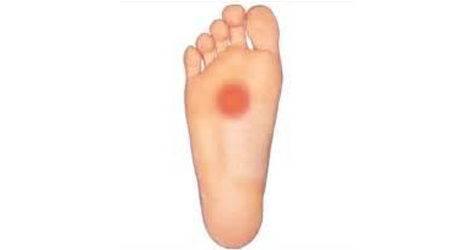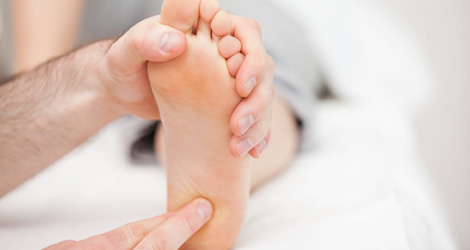
Metatarsalgia is pain and inflammation that occurs in the ball of foot and is a result of injury from overuse. It often occurs in the metatarsal heads – where the three middle toes meet the ball of the foot. It is a common problem which can affect the bones and joints of the metatarsals.
Most commonly, the first metatarsal head is affected – the ball of the foot just behind the big toe. The severity of the pain can vary and may affect parts of the foot or sometimes the whole foot or even both feet might be affected. Metatarsalgia can get worst with weight bearing such as when standing, walking, or running.
Although the condition is not considered as serious, it can be quite painful and patients may have to stay off their feet for a while to heal the inflammation.
Custom orthotics with modifications as well as Orthopedic shoes are good solutions for metatarsalgia.

Metatarsalgia is a type of pain and inflammation that occurs in a part of the foot known as the metatarsal (ball of foot). It often occurs in the metatarsal heads – where the three middle toes meet the ball of the foot. It is a common problem which can affect the bones and joints of the metatarsals.
Most commonly, the first metatarsal head is affected – the ball of the foot just behind the big toe. The severity of the pain can vary and may affect just one or two toes – sometimes the whole foot or even both feet might be affected. Metatarsalgia can worsen when weight is put on the foot, as may be the case when standing, walking, or running. Metatarsalgia can affect males and females of all ages, but is most common in middle aged females.
Although the condition is not considered as serious or life-threatening in any way, it can be quite painful and the patient may be sidelined by it.
Causes
- Overuse. For example, in runners and athletes, which can cause some mild inflammation in the metatarsal heads and nearby joints. Other sports such as tennis or sports that involve jumping may also put extra stress on the metatarsal heads and lead to inflammation and pain.
- Wearing high-heeled shoes. This can put extra stress on the metatarsal heads. Footwear that is poorly fitted or too tight may also be a cause.
- Being overweight. This can put extra stress on the feet in general.
- Having a stiff ankle or Achilles tendon (the tendon at the heel). This can affect the way that pressure is distributed across the foot and may lead to extra stress on the metatarsal heads.
- Morton’s neuroma. This is sometimes called Morton’s metatarsalgia. It is a condition that affects one of the nerves that run between the metatarsal bones in the foot (the plantar)
- Claw foot (pes cavus). Pes cavus can mean that extra stress is placed on the ball of the foot, which can lead to metatarsalgia.
- Hammer toe or claw toe deformity. With a claw toe the joint with the metatarsal bone is bent upwards, the middle joint in the toe is bent downwards and the end joint in the toe may also be bent downwards. These toe deformities can mean that extra stress is placed on the ball of the foot, which can lead to metatarsalgia.
- Bunion (hallux valgus). A bunion puts extra stress on the ball of the foot and this can lead to metatarsalgia.
- Arthritis or gout. This can cause inflammation of the joints in the ball of the foot or of the big toe and can be a cause of metatarsalgia.
- Diabetes. This can cause damage to the nerves in the feet and can be a cause of metatarsalgia.
Treatments we provide
- Custom orthotics. Custom orthotics with a built on metatarsal pad serves to offload pressure from painful areas.
- The application of cold pack or ice is another conservative treatment we provide


